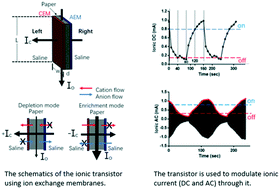Ionic transistor using ion exchange membranes
Abstract
Ionic transistors can be used to modulate ionic current in a way that is analogous to their electronic counterparts. An ionic transistor can reversibly change its ionic conduction to control ionic current by injecting electrical charges. To facilitate its applications in biomedical devices (e.g., controlled drug delivery, rectification of ionic current, and signal processing), an ionic transistor should maintain high performance of ionic current control within physiological solutions (e.g., 0.9% NaCl) for long durations. Here, we introduce an ionic transistor using cation and anion exchange membranes (CEM and AEM). It could impose a 10× impedance change in a channel filled with 0.9% NaCl solution and we observed a stable modulation of ionic current throughout a test of 1000 cycles of on/off switching of the ionic transistor.



 Please wait while we load your content...
Please wait while we load your content...